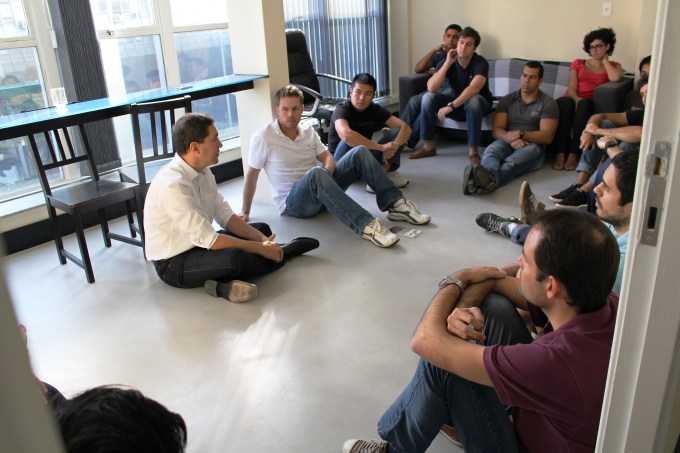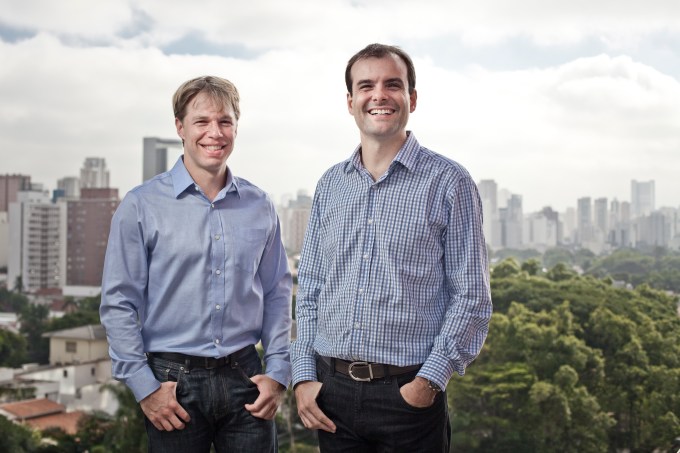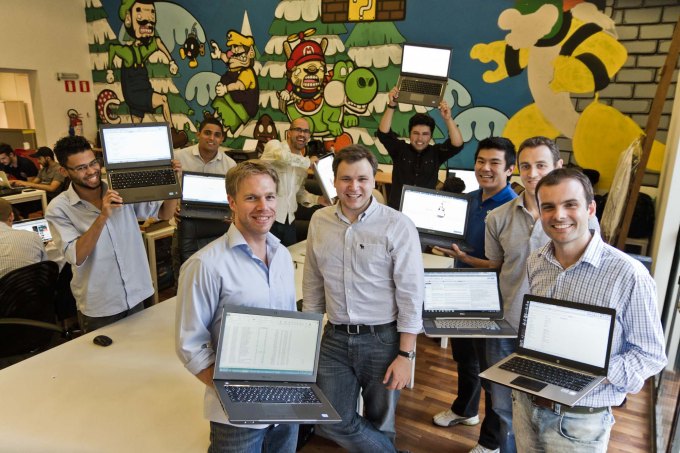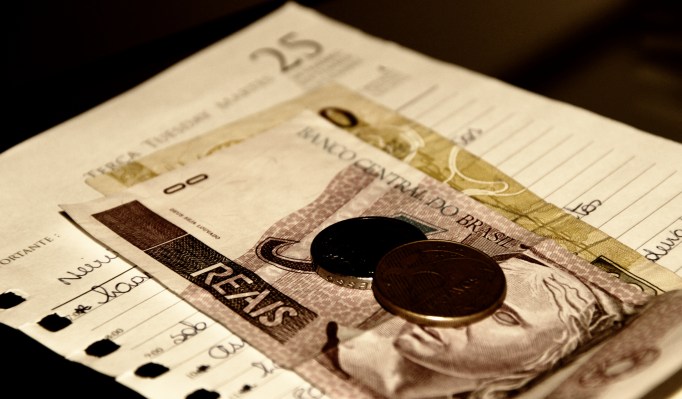Editor’s note: Julie Ruvolo is a freelance writer and editor of RedLightR.io and RioChromatic.com.
In August a new, homegrown entry raced onto Brazil’s top 10 most downloaded apps. It’s a list usually cluttered by American-made social media, music and gaming apps; but GuiaBolso, a Mint-style personal finance app joined the App Store on July 2 when Brazil was midway through a month-long World Cup paralysis and passed Tinder, Facebook and even WhatsApp over the last month to reach the No. 5 most downloaded app in Brazil, with no official launch announcement or marketing budget.
The novelty of one app to rule all of your bank and credit card accounts, and Mint’s ensuing acquisition by Intel in 2009, is already ancient digital history in the U.S. But despite over a billion dollars of investment in personal finance companies, GuiaBolso, a startup co-founded by Benjamin Gleason, former managing director of Groupon Brazil and CFO of Groupon Latin America, and Thiago Alvarez, a long-time McKinsey alum working with the Brazilian banking industry, is the first company to enter the Brazilian market.
“We’re the only ones in Brazil,” Gleason told me on a call from São Paulo, where GuiaBolso is headquartered. “People have been saying, “We finally have Mint in Brazil. Why didn’t this come sooner?” Gleason says everyone he and Alvarez talked to, including a number of companies doing personal financial aggregation internationally, thought it would be impossible in Brazil. “The challenge was building the technology,” says Gleason. “Everyone thinks the banks are giving us their APIs but that’s not the way it works.”
Yodlee, founded in 1999, was the first company to figure out the data integration necessary to launch a financial tracking service, Gleason says They currently power over 500 financial apps, including white-hot LearnVest, a personal finance management startup founded by 30-year-old Alexa Von Tobel that has raised $69 million in venture capital. “The other part is that people were afraid of what the reaction of the Brazilian banks would be, and didn’t want to take that risk,” Gleason says. “So we knew the institutional side would be important.”
Gleason and Alvarez are well-prepared to navigate the political waters of disrupting the financial industry. In addition to their banking industry contacts from stints at Groupon and McKinsey, they have the support of experts like Neil Daswani, a former early Yodlee employee, web application security expert and professor at Stanford, and Gabriel Jaramillo, a founding partner at Valor Capital and former president of Brazil’s Santander Bank.
 Valor participated in GuiaBolso’s $1M seed round in March of 2013, along with Brazilian e.Bricks and six angel investors. Valor and e.Bricks returned for a $3 million Series A this May, led by Kaszek Ventures, and Kaszek Ventures’ co-founder Nicolas Szekasy joined the board with e.Bricks’ Pedro Melzer.
Valor participated in GuiaBolso’s $1M seed round in March of 2013, along with Brazilian e.Bricks and six angel investors. Valor and e.Bricks returned for a $3 million Series A this May, led by Kaszek Ventures, and Kaszek Ventures’ co-founder Nicolas Szekasy joined the board with e.Bricks’ Pedro Melzer.
Brazil’s decade-long economic boom has lifted some 50 million Brazilians out of poverty and into the working class, but has had some unintended consequences. Even as Brazil’s Central Bank reported that household income has doubled and unemployment has fallen by half, has meant more purchases, more consumer debt, and ironically, higher prices.
“Wages started rising, unemployment fell and there was a big boom in terms of access to credit cards and car loans, but the consumer-led demand was unsustainable,” Gleason explains. “Default rates started spiking, and with 10-12% interest on credit cards in Brazil, once you get into a hole you can’t get out. So you had this whole drive leading people to not controlling their finances or being able to pay back their loans.”
At the same time, Brazilians were coming online in droves – 100 million people, or half of Brazil’s population, came online in the last decade – and started taking out their credit cards. “Collective buying was a driver, because the ticket price of items on sites like Groupon was lower than big ticket items like TVs and fridges, and it seemed like you were getting a good deal, so literally millions of people joined the ecommerce wave, and that was really the start of it,” Gleason says. “I joined Groupon Brazil right at the beginning and caught the huge boom of the collective buying craze. We went from zero to 700 employees in a few months. It was out of control – we were just trying to keep the wheels from falling off.”
But after Groupon’s IPO in 2011, the startup party turned corporate, and Gleason decided it was finally time to start something from scratch, after years of exchanging ideas with Alvarez since they met at McKinsey in 2007.
“Two things that came out of that experience,” Gleason says. “In Brazil, interest rates don’t really mean much to people. They are only thinking about the installment they have to pay. The other thing is that people don’t consider themselves in debt if all their payments are current. So if they have a car loan and credit card balance and are paying it every month, they say they don’t have debt, until they start to default.”
“At the same time, Thiago was seeing these extremely lucrative banks with all kinds of money and doing nothing to innovate, while on the other hand you have Brazilian consumers, very low levels of financial education, who really don’t understand the basic banking products being pushed at them,” says Gleason. According to 2014 research by Brazil’s National Confederation of Shopkeepers, 82% of Brazilians say they don’t know how to control their finances. “It became clear that there’s a huge knowledge gap, and the Brazilian banks are not interested in creating new tools for consumers to narrow it.”
 GuiaBolso began as a humble operation out of Gleason’s house in São Paulo in 2012. “We intentionally started out by bootstrapping to manage dilution and know exactly what product we wanted to go forward with,” says Gleason. “We embraced all the lean startup stuff. We threw up a landing page and started to see what people were searching for.
GuiaBolso began as a humble operation out of Gleason’s house in São Paulo in 2012. “We intentionally started out by bootstrapping to manage dilution and know exactly what product we wanted to go forward with,” says Gleason. “We embraced all the lean startup stuff. We threw up a landing page and started to see what people were searching for.
And one of the first things we found is that most people who were looking for financial guidance online were from the emerging “C” class, and most of their problems had to do with debt or not being able to balance their budget.” (Media reports often cite that millions of Brazilians were lifted into the middle class, but it’s a misnomer – Brazil’s “C” class, on a scale of A through E, is what Americans would consider working class, making about $1,500-$2,500 household income per month.)
GuiaBolso’s first product, launched with their seed round funding in May of 2013, after a year of testing and 4,000 financial consultations in person and via the website, was an online financial consultant that solicited a few data points about the visitor’s financial situation and offered customized and specific advice. But the experience was designed as a one-off tool and required manually inputting your information.
“That wasn’t going to be effective over time, so we looked at other markets in the personal finances management space. Mint dominated but all the offshoots went for different niches, like LearnVest [a platform originally designed for young professional women]. They were all using integration with bank accounts to generate tools and recommendations, and in Brazil there has never been account aggregation where you can see all your accounts together in one place, so we shifted our focus to that.”
Gleason and Alvarez started off looking for bridge financing, but Gleason says the American venture funds wanted to write bigger checks. They ended up closing a Series A after all, led by Buenos Aires-based Kaszek Ventures, which backed the Latin American success MercadoLibre.
GuiaBolso launched their automated product in April of this year, which organizes three months of historical from Brazilian banks Itau, Bradesco, Santander and Banco do Brasil, representing about 80% of the retail banking market, into pie charts and primary colors of spending breakdowns versus goals set. “Brazil is different than the U.S.,” Gleason says. “Everything is usually concentrated in one bank, credit cards are issued via the bank, and all of their investments and debt are with the same bank.”
Gleason says next priorities are to connect to the Caixa Economica (Brazil’s Federal Savings Bank), Citi and HSBC. “Then there are a few independent credit card companies – Amex, and store-issued credit cards like Casas Bahia.”
While GuiaBolso’s first version catered to Brazilians in the working “C” class, the automated product is seeing primary adoption from Brazil’s “A” and “B” classes, for obvious reasons: wealthier Brazilians are more likely to have a bank account and use online banking, have a higher percentage of electronic versus cash transactions, and are more likely to have an iPhone on which they can download the GuiaBolso app.
Gleason sees that changing as internet access and smartphone penetration keep expanding to Brazil’s lower income classes. “Our target market is the 50 million checking accounts in Brazil that are eligible for internet banking,” Gleason says, “and they’re projected to grow 40% by 2017, according to 2012 data from CIAB FEBRABAN.”
“But across all levels of income, people have no clue how to manage their finances,” Gleason says. According to a sample of 6,000 GuiaBolso users, about one-third of all expenses are credit card purchases paid for in installments, regardless of the user’s income level. But while that represents only 4% of monthly income for users making over $5,000 a month, it’s 10% of monthly income for users in the lowest income bracket. “People making less income are the biggest hostages to installment payments. We were shocked.”
It’s representative of bigger, troubling patterns in Brazil’s economy. Since 2008, consumer loans have more than doubled to around $600 billion, and household consumer debt has almost doubled to 25.6% of Brazil’s GDP. In 2013, Brazilians spent $233 billion on short-term interest payments, representing two months of their annual income. “That compares to about 10% in the US,” Gleason says, “But it’s worse: half of the debt in the US is in mortgages, while in Brazil it’s mostly short-term debt.”

In other words, it’s an opportune moment to launch free financial planning tools that make it really easy to break down and manage your monthly income and expenses. “Our web product was growing 30% month over month with very little spending on paid marketing,” Gleason says, “and we were pretty happy with that, but our plans changed dramatically after launching the iPhone app in July. We’ve already hit our growth targets for the year and have surpassed $1 billion worth of user financial transactions organized on our platform.”
At this rate, GuiaBolso may have the opportunity to figure out the big question Mint got to bypass after it was acquired by Intuit: How to make money. “It’s a free app, and our focus is to keep growing and see where we can help people,” says Gleason, “so revenue is not on the dashboard for now. But if we can keep engagement high and acquire users cheaply, we can do a lot of experimentation with the LearnVest model for advising and long term planning, as well as offer our users products that are suited for them. But I don’t want to send 100,000 people a credit card offer or serve them any banner ads.”
Image by Flickr user Victor Camilo
